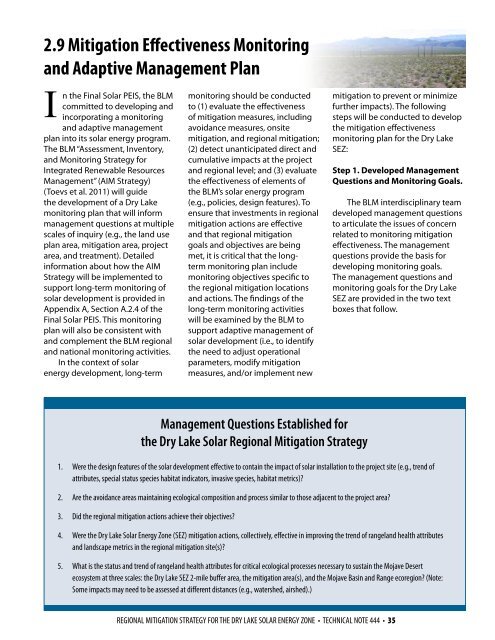xs7hy9e06w?redirect_to=http://www.blm.gov/pgdata/etc/medialib/blm/wo/blm_library/tech_notes.Par.29872.File.dat/TN_444
xs7hy9e06w?redirect_to=http://www.blm.gov/pgdata/etc/medialib/blm/wo/blm_library/tech_notes.Par.29872.File.dat/TN_444
xs7hy9e06w?redirect_to=http://www.blm.gov/pgdata/etc/medialib/blm/wo/blm_library/tech_notes.Par.29872.File.dat/TN_444
You also want an ePaper? Increase the reach of your titles
YUMPU automatically turns print PDFs into web optimized ePapers that Google loves.
2.9 Mitigation Effectiveness Monitoring<br />
and Adaptive Management Plan<br />
I<br />
n the Final Solar PEIS, the BLM<br />
committed to developing and<br />
incorporating a monitoring<br />
and adaptive management<br />
plan into its solar energy program.<br />
The BLM “Assessment, Inventory,<br />
and Monitoring Strategy for<br />
Integrated Renewable Resources<br />
Management” (AIM Strategy)<br />
(Toevs et al. 2011) will guide<br />
the development of a Dry Lake<br />
monitoring plan that will inform<br />
management questions at multiple<br />
scales of inquiry (e.g., the land use<br />
plan area, mitigation area, project<br />
area, and treatment). Detailed<br />
information about how the AIM<br />
Strategy will be implemented to<br />
support long-term monitoring of<br />
solar development is provided in<br />
Appendix A, Section A.2.4 of the<br />
Final Solar PEIS. This monitoring<br />
plan will also be consistent with<br />
and complement the BLM regional<br />
and national monitoring activities.<br />
In the context of solar<br />
energy development, long-term<br />
monitoring should be conducted<br />
to (1) evaluate the effectiveness<br />
of mitigation measures, including<br />
avoidance measures, onsite<br />
mitigation, and regional mitigation;<br />
(2) detect unanticipated direct and<br />
cumulative impacts at the project<br />
and regional level; and (3) evaluate<br />
the effectiveness of elements of<br />
the BLM’s solar energy program<br />
(e.g., policies, design features). To<br />
ensure that investments in regional<br />
mitigation actions are effective<br />
and that regional mitigation<br />
goals and objectives are being<br />
met, it is critical that the longterm<br />
monitoring plan include<br />
monitoring objectives specific to<br />
the regional mitigation locations<br />
and actions. The findings of the<br />
long-term monitoring activities<br />
will be examined by the BLM to<br />
support adaptive management of<br />
solar development (i.e., to identify<br />
the need to adjust operational<br />
parameters, modify mitigation<br />
measures, and/or implement new<br />
mitigation to prevent or minimize<br />
further impacts). The following<br />
steps will be conducted to develop<br />
the mitigation effectiveness<br />
monitoring plan for the Dry Lake<br />
SEZ:<br />
Step 1. Developed Management<br />
Questions and Monitoring Goals.<br />
The BLM interdisciplinary team<br />
developed management questions<br />
to articulate the issues of concern<br />
related to monitoring mitigation<br />
effectiveness. The management<br />
questions provide the basis for<br />
developing monitoring goals.<br />
The management questions and<br />
monitoring goals for the Dry Lake<br />
SEZ are provided in the t<strong>wo</strong> text<br />
boxes that follow.<br />
Management Questions Established for<br />
the Dry Lake Solar Regional Mitigation Strategy<br />
1. Were the design features of the solar development effective to contain the impact of solar installation to the project site (e.g., trend of<br />
attributes, special status species habitat indicators, invasive species, habitat metrics)?<br />
2. Are the avoidance areas maintaining ecological composition and process similar to those adjacent to the project area?<br />
3. Did the regional mitigation actions achieve their objectives?<br />
4. Were the Dry Lake Solar Energy Zone (SEZ) mitigation actions, collectively, effective in improving the trend of rangeland health attributes<br />
and landscape metrics in the regional mitigation site(s)?<br />
5. What is the status and trend of rangeland health attributes for critical ecological processes necessary to sustain the Mojave Desert<br />
ecosystem at three scales: the Dry Lake SEZ 2-mile buffer area, the mitigation area(s), and the Mojave Basin and Range ecoregion? (Note:<br />
Some impacts may need to be assessed at different distances (e.g., watershed, airshed).)<br />
REGIONAL MITIGATION STRATEGY FOR THE DRY LAKE SOLAR ENERGY ZONE • TECHNICAL NOTE <strong>444</strong> • 35


